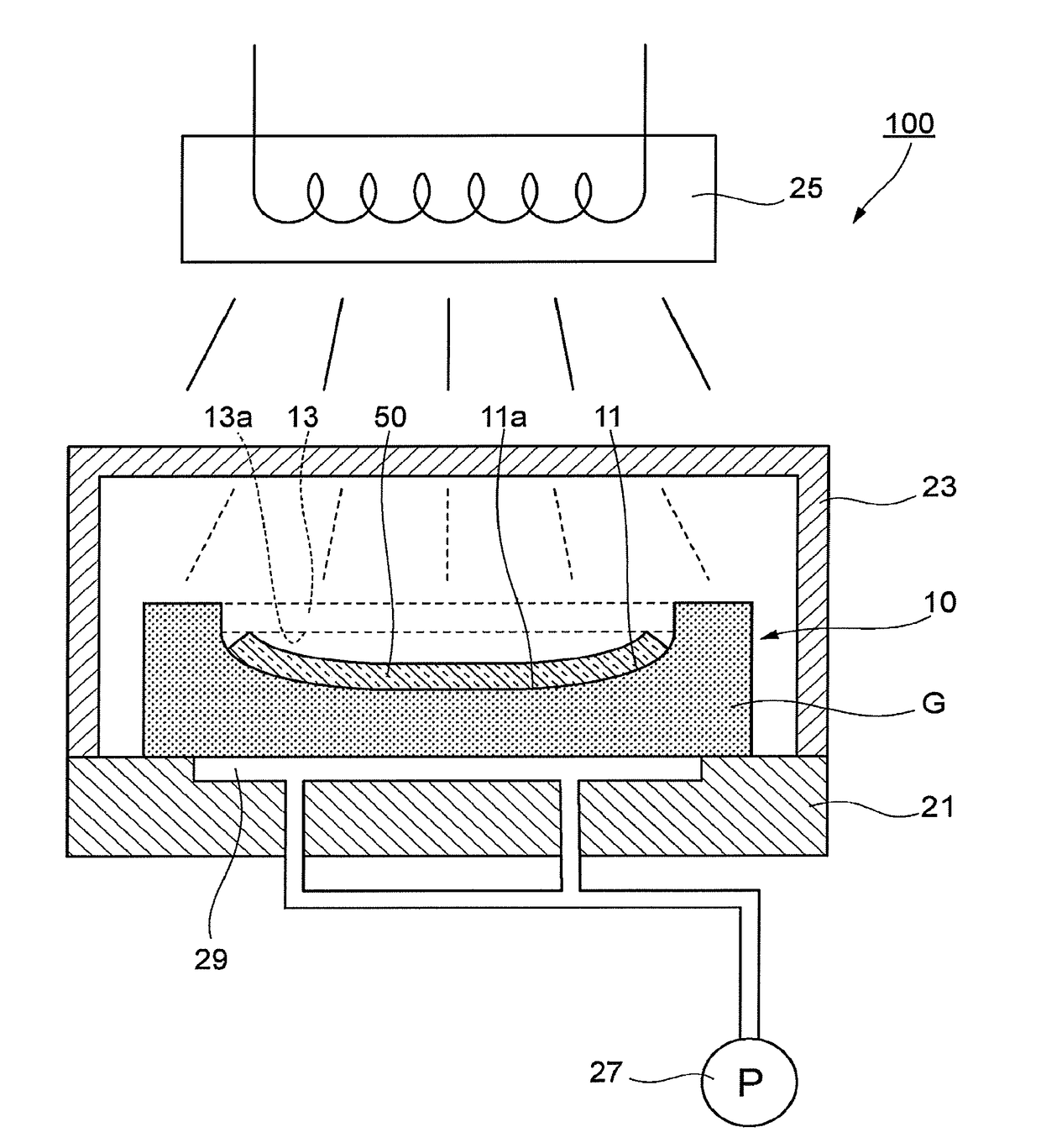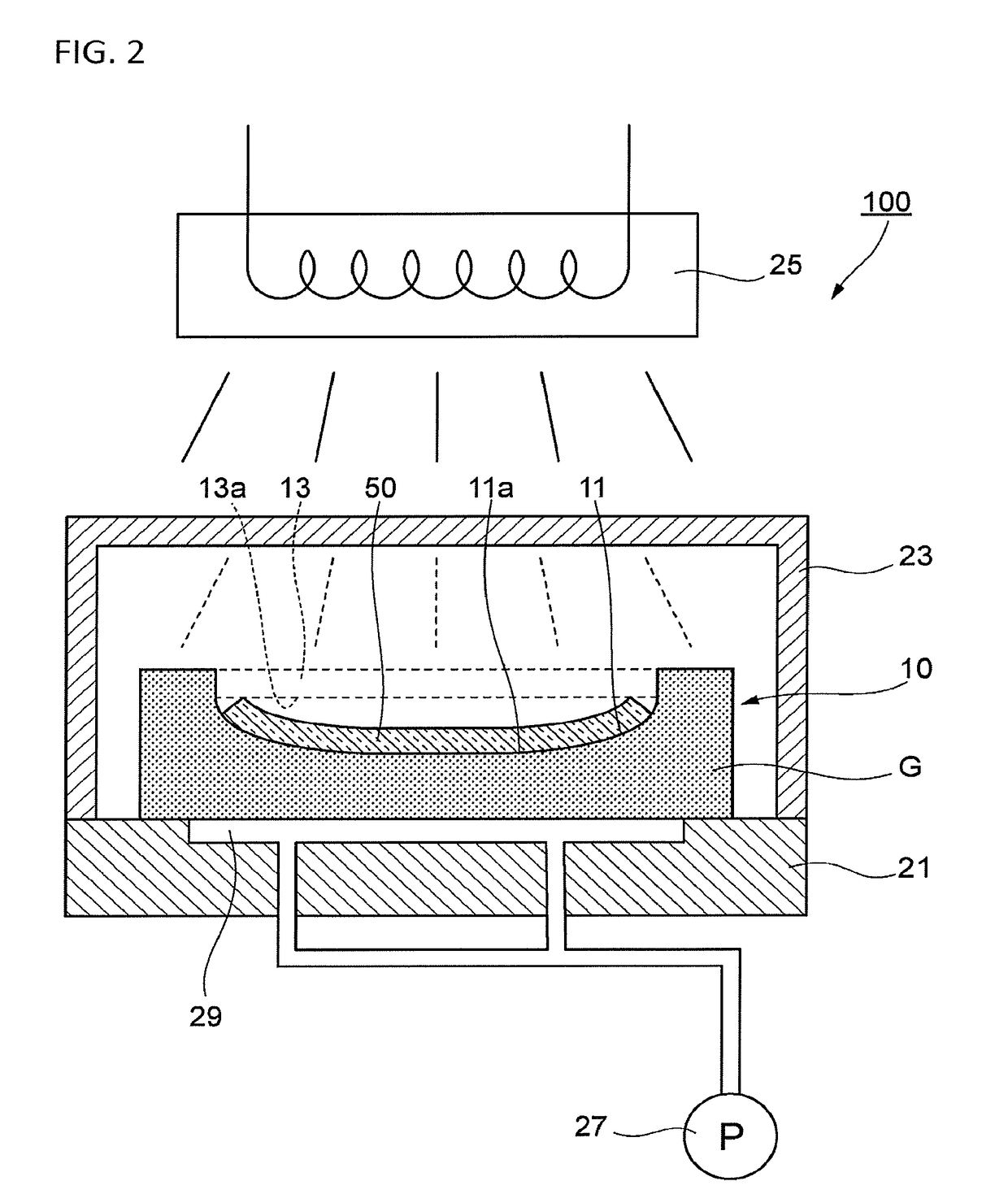Mold, molding apparatus, and production method of bent glass
a production method and mold technology, applied in glass reforming apparatus, glass making apparatus, manufacturing tools, etc., can solve the problems of high cost of materials, easy contamination of molds, so as to achieve simple and easy production and increase productivity
- Summary
- Abstract
- Description
- Claims
- Application Information
AI Technical Summary
Benefits of technology
Problems solved by technology
Method used
Image
Examples
first configuration example
[0024]FIG. 1 shows a cross-sectional view of the mold of this embodiment.
[0025]The mold 10 for molding a bent glass has a concave molding surface 11 on the top surface. The molding surface 11 has the same surface shape as the design shape of a bent glass having a curvature part.
[0026]A glass to be molded 13 as a body to be molded is placed on the mold 10, and the glass to be molded 13 is heated to a temperature not less than the softening point. The heated glass to be molded 13 deforms along the molding surface 11 due to softening by heating and the later-described exterior force such as gravity, suction power and pressing force, and a first main surface 13a abuts the molding surface 11 of the mold 10. The shape of the molding surface 11 is thereby transferred to the glass to be molded 13. The glass to be molded 13 is preferably heated such that the equilibrium viscosity becomes from 106.5 Pa·s to 1012.5 Pa·s. The equilibrium viscosity is more preferably from 107 Pa·s to 1010 Pa·s. ...
second configuration example
[0083]FIG. 4 is a cross-sectional view of a main part of a molding apparatus illustrating a second configuration example of the mold.
[0084]In the mold 10A of this configuration, a suction hole 17 extended from the molding surface 11 to the back surface on the opposite side of the molding surface 11 is formed. The opening 18 of the suction hole 17 open to the back surface of the mold is arranged to face the suction path 29, and a negative pressure from the suction path 29 is supplied to the suction hole 17.
[0085]In this mold 10A, the glass to be molded 13 is caused to follow the molding surface 11 by supplying a negative pressure to the suction path 29 and the suction hole 17 by a suction pump (not shown). In this case, a negative pressure is supplied from the suction path 29 to the molding surface 11 side through voids of the mold 10A and since a negative pressure is directly supplied to the molding surface 11 side also from the suction hole 17, the supply speed of the negative pres...
third configuration example
[0087]FIG. 5 is a cross-sectional view of a main part of a molding apparatus illustrating a third configuration example of the mold.
[0088]The mold 10B of this configuration molds a bent glass 50 by a gravity molding process.
[0089]In the gravity molding process, a glass to be molded 13 is placed on the mold 10, and the glass to be molded 13 is heated, softened and deformed downward by its own weight. As a result, the first main surface 13a of the glass to be molded 13 is brought into contact with the molding surface 11, and the shape of the molding surface 11 is transferred to the glass to be molded 13.
[0090]In the mold 10B of this configuration, a negative pressure need not to be supplied, and installation of a suction pump or a suction channel is unnecessary. In addition, the negative pressure supplied, the timing of supply, etc. need not be controlled, and the configuration of the molding apparatus and the control for molding can be simplified. As for actions and effects of this c...
PUM
| Property | Measurement | Unit |
|---|---|---|
| porosity | aaaaa | aaaaa |
| porosity | aaaaa | aaaaa |
| arithmetic average roughness | aaaaa | aaaaa |
Abstract
Description
Claims
Application Information
 Login to View More
Login to View More - R&D
- Intellectual Property
- Life Sciences
- Materials
- Tech Scout
- Unparalleled Data Quality
- Higher Quality Content
- 60% Fewer Hallucinations
Browse by: Latest US Patents, China's latest patents, Technical Efficacy Thesaurus, Application Domain, Technology Topic, Popular Technical Reports.
© 2025 PatSnap. All rights reserved.Legal|Privacy policy|Modern Slavery Act Transparency Statement|Sitemap|About US| Contact US: help@patsnap.com



